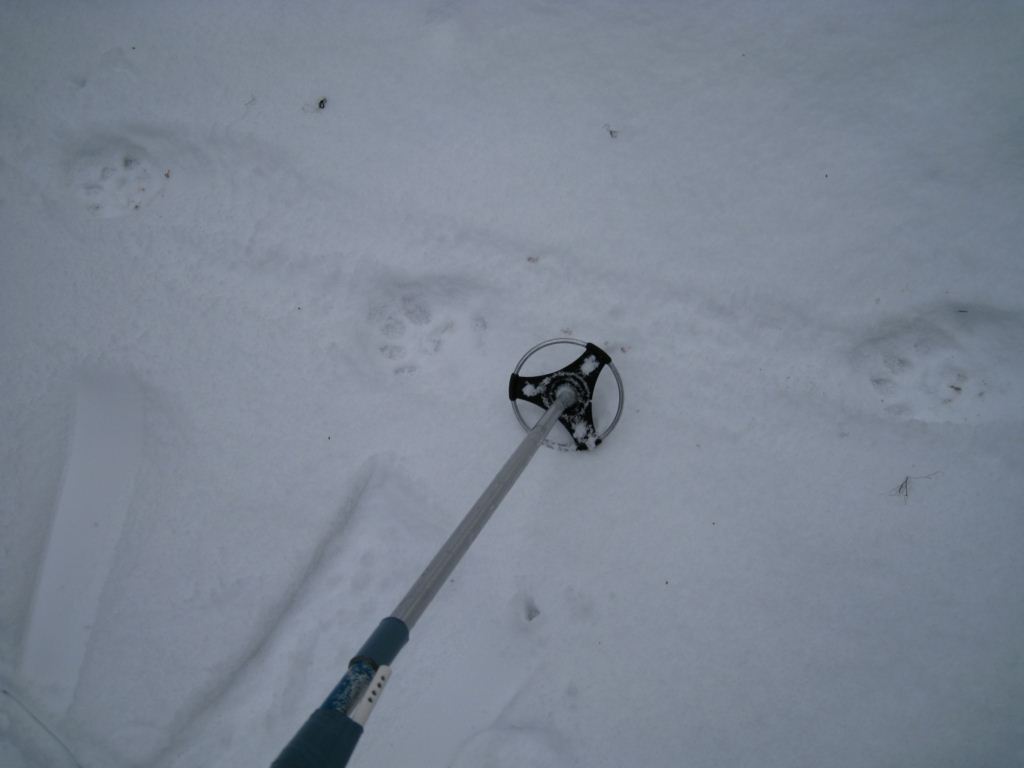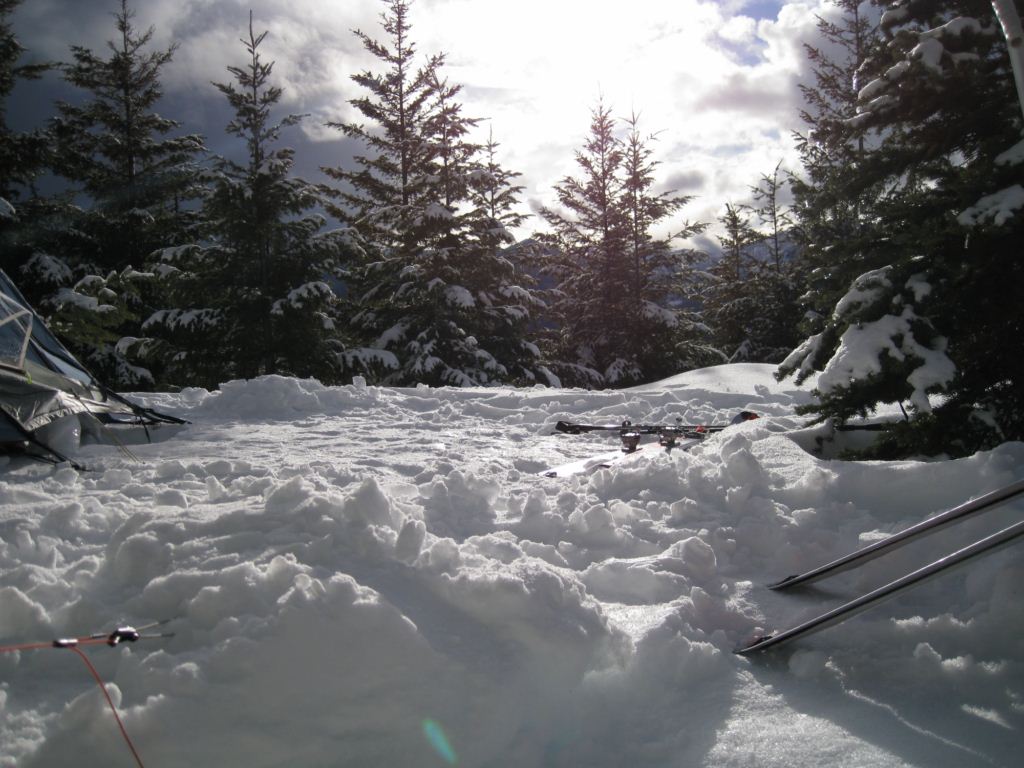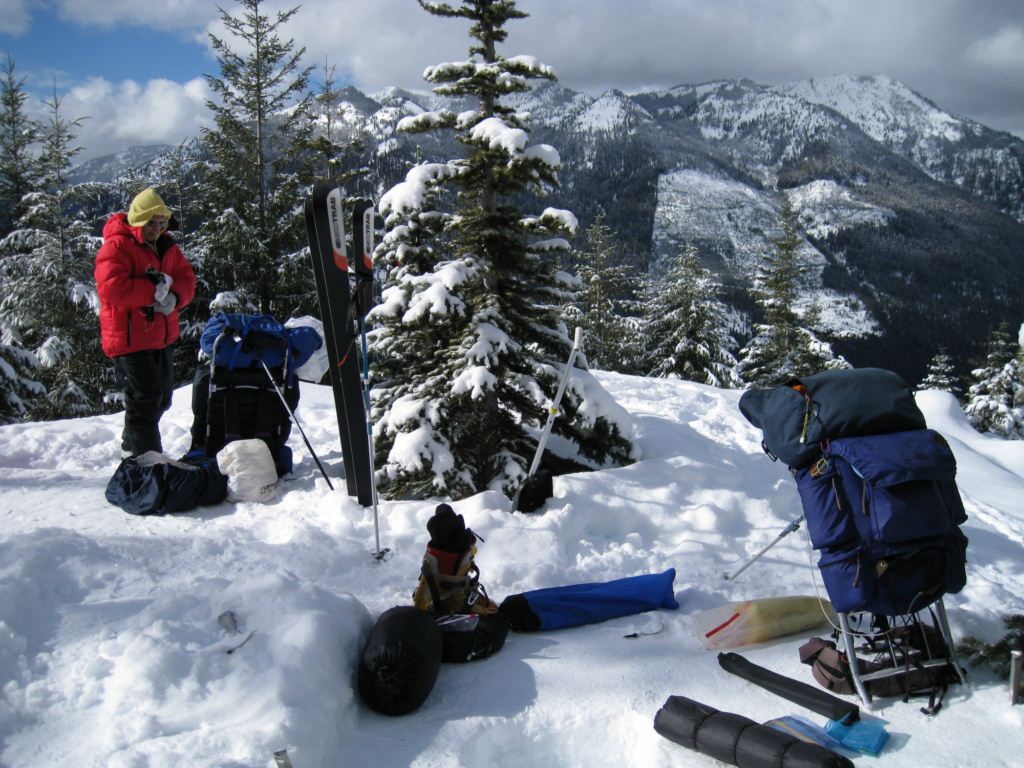Feb 17-18, 2011, Sasse Ridge
2/17/11
3196
6
Having put off this trip a couple of times because of the weather, Jane and I decided that it was time to just go. We were considering it just a backpacking trip on skis - but you never know unless you go. It turned out that the skiing was *excellent*.
Lots of animals about. On the way in we saw quite fresh cougar tracks, conveniently for us, heading downhill. See the pic below. The Snotel site data suggests that the snow stopped about 2 am, so the tracks must have been quite recent. My powder basket is 5 inches in diameter by the way. That was a big kitty! On Friday we saw older tracks, most likely cougar, coming over Sasse Ridge, heading straight down. Perhaps it was the big male known to frequent the area, coming back from a trip to the Teanaway. The males have a territory of roughly 150 square miles. Tons of snowshoe rabbit tracks, and we even saw one perhaps 100 feet behind our tents. They are normally extremely shy, so that was a treat. We also saw fresh martin tracks, and fresh bobcat tracks too. It's a privilege to ski in this area and know that you are in an area that is still wild.
After we set up camp it snowed another inch or so, and then cleared off. See the pic from my tent window below.
We had our doubts about how good the skiing would be on Friday because of the limited snowpack, and all the little trees, and even half way up the frontside it was still in doubt. There was however about 6 to 8 inches of new snow by then, and remembering our favorite low-snow-year run down, the skiing was great. As far as total snow depth, it varied from a foot at the parking lot to 3 feet plus at 4300 feet in roughly a linear fashion. The snowpack model says that it continues linearly as your go up further. By roughly 4800 to 5000 feet, the large tree wells and holes on the down side of stumps and rocks are largely gone. Below that you have to be careful.
The final pic is of us packing up after a nice long nap. I wonder if anyone is thinking 'why do they use those ridiculous old packs?' :-) (Note the adapted Ospery thermo-fitted hip belt on mine.)
Lots of animals about. On the way in we saw quite fresh cougar tracks, conveniently for us, heading downhill. See the pic below. The Snotel site data suggests that the snow stopped about 2 am, so the tracks must have been quite recent. My powder basket is 5 inches in diameter by the way. That was a big kitty! On Friday we saw older tracks, most likely cougar, coming over Sasse Ridge, heading straight down. Perhaps it was the big male known to frequent the area, coming back from a trip to the Teanaway. The males have a territory of roughly 150 square miles. Tons of snowshoe rabbit tracks, and we even saw one perhaps 100 feet behind our tents. They are normally extremely shy, so that was a treat. We also saw fresh martin tracks, and fresh bobcat tracks too. It's a privilege to ski in this area and know that you are in an area that is still wild.
After we set up camp it snowed another inch or so, and then cleared off. See the pic from my tent window below.
We had our doubts about how good the skiing would be on Friday because of the limited snowpack, and all the little trees, and even half way up the frontside it was still in doubt. There was however about 6 to 8 inches of new snow by then, and remembering our favorite low-snow-year run down, the skiing was great. As far as total snow depth, it varied from a foot at the parking lot to 3 feet plus at 4300 feet in roughly a linear fashion. The snowpack model says that it continues linearly as your go up further. By roughly 4800 to 5000 feet, the large tree wells and holes on the down side of stumps and rocks are largely gone. Below that you have to be careful.
The final pic is of us packing up after a nice long nap. I wonder if anyone is thinking 'why do they use those ridiculous old packs?' :-) (Note the adapted Ospery thermo-fitted hip belt on mine.)



Great pics Lar!
I would also like to add a comment about gear. Outer hardshells to be specific. I had gotten increasingly wet over the last year or so as my 13 year old Patagonia Storm parka delaminated inder the pack straps. After getting drenched in our previous trip it was suggested that I sent my parka back to Patagonia for warranty. I thought that was a little over the top, but with the cost of a replacement at $400+ I decided to try. I was totally amazed to get a credit for my old one for $325. Of course that meant I had to find a Patagonia replacement. I went to the web site, looking for a winter overnight stand around in temps down to zero and fit over all my other layers hardshell. Not heavy, not too many pockets, two way zipper, 3 layer breathable, no bells and whistles.
I am 5' tall and weigh 125. I ended up with a men's large, fitting perfectly over the layers you see in the packing up tents picture, only the sleeves are a little long. It is exactly the same size as my old men's small, except for the sleeve length. I love it!
What do large men will do if they go out overnight? Cardinal rule, you just can't compress your insulating layers.
I would also like to add a comment about gear. Outer hardshells to be specific. I had gotten increasingly wet over the last year or so as my 13 year old Patagonia Storm parka delaminated inder the pack straps. After getting drenched in our previous trip it was suggested that I sent my parka back to Patagonia for warranty. I thought that was a little over the top, but with the cost of a replacement at $400+ I decided to try. I was totally amazed to get a credit for my old one for $325. Of course that meant I had to find a Patagonia replacement. I went to the web site, looking for a winter overnight stand around in temps down to zero and fit over all my other layers hardshell. Not heavy, not too many pockets, two way zipper, 3 layer breathable, no bells and whistles.
I am 5' tall and weigh 125. I ended up with a men's large, fitting perfectly over the layers you see in the packing up tents picture, only the sleeves are a little long. It is exactly the same size as my old men's small, except for the sleeve length. I love it!
What do large men will do if they go out overnight? Cardinal rule, you just can't compress your insulating layers.
Great stuff as usual, you two. Thanks for the report. Anastasia & company saw the Paradise fox over in the Tattoosh the other day -- cool to find traces of the critters around.
Hey Lar,
It is great to see that the snow returned to the front side for you two. Sounds like it was fun. Good skiing,good tracking. It makes me wonder if that is the same cat we almost ran into, missing by a few minutes, back in December??
J
It is great to see that the snow returned to the front side for you two. Sounds like it was fun. Good skiing,good tracking. It makes me wonder if that is the same cat we almost ran into, missing by a few minutes, back in December??
J
author=John_Morrow link=topic=19681.msg83698#msg83698 date=1298258234]
It makes me wonder if that is the same cat we almost ran into, missing by a few minutes, back in December??
J
John, I forgot to mention that we saw what were likely cougar tracks going down the road from the parking lot overlook - - just like the ones we saw! They were probably 1 or 2 days old; further down they were obscured by snowmobile tracks, which were impressed into at least some of the newer snow. The fresh tracks we saw at 2800 feet followed the south side of Salmon La Sac Creek (our typical route) Can you put this together somehow?
I also forgot to mention that we saw quite fresh coyote tracks too.
Hello Larry, & Larry's sister
Thanks for this and your many previous postings! You guys are the one consistent window into conditions and adventure in the Cle Elm drainage, to say nothing of your useful tips and great practices! Keep it up. So I'll bite: how come you are using those ridiculously old school pack's we all used to value so highly?
Thanks much!
Thanks for this and your many previous postings! You guys are the one consistent window into conditions and adventure in the Cle Elm drainage, to say nothing of your useful tips and great practices! Keep it up. So I'll bite: how come you are using those ridiculously old school pack's we all used to value so highly?
Thanks much!
author=GerryH link=topic=19681.msg83898#msg83898 date=1298414596]
Hello Larry, & Larry's sister
Thanks for this and your many previous postings! .... So I'll bite: how come you are using those ridiculously old school pack's we all used to value so highly?
Thanks much!
Thanks so much GerryH; sometimes I wonder about posting. Overnight packs – I could end up writing way too much on the subject. Both Jane and I have bad shoulders, and we are both getting older, and we like to carry enough stuff so we are comfortable no matter *what* the weather. So we are carrying far more than the recommended percentage of body weight, which means that we have to carry the weight with the least effort possible for us so we can do what we like to do. I’m not sure what the current theory of internal frame packs is, but when they first came in, the idea was that they were restricted in width so that your arms have plenty of freedom, and they don’t shift around as much when climbing or skiing. If you squish the pack in sideways, for the same volume there is more weight further back, which increases the load on the shoulders and tends to tip you over backwards. You can lean forward to get the CG of the pack almost over your hips, but that is tiring. I also think that it’s harder to carry a very high percentage of the pack weight on your hips using an internal frame pack.
Jane and I regard skiing out with the pack as transportation so the issue of the heavy pack moving around more is not important to us; for the fun skiing we use fanny packs. For me, an external frame pack with an extension bar which supports an extension bag gets the weight much further forward than with an internal frame. By the way, our custom extension bags when unloaded also function as fanny packs with the addition of a belt that attaches with Velcro. Mine also converts to a day pack with shoulder straps. This means that we don’t have to carry a separate day pack.
With a good hip belt I can get maybe 80% or more of the weight on my hips and yet have a fairly erect posture. The CG of the pack ends up almost directly above the hip belt attachment. It’s way more comfortable for me. A good hip belt is important; a long time ago I made a custom hip belt that fit my anatomy. It worked very well for a long time, but it finally wore out. Fortunately Osprey had just come out with a thermo-fitted hip belt that could be used as an upgrade to their standard hip belt. Although they are designed for a specific internal frame pack, I managed to adapt one for my pack, and thermo fitted it at home - - it’s not hard. It’s been very effective for me. I would say it’s like taking maybe 15 pounds out of the pack. The further advantage of it is that by disconnecting the strap that holds it up (so you can shrug your shoulders and have the hip belt lift up), the hip belt swivels 180 degrees so that the pack lies flat in the tent, and is not propped up by the fairly stiff hip belt.
All this is just personal preference. Opps, this ended up too long in spite of myself. :-)
Reply to this TR
Please login first:
